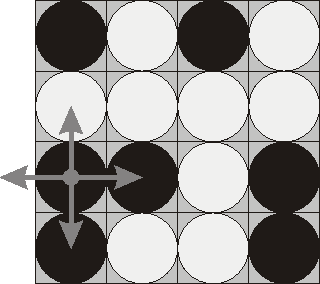Flip Game
| Time Limit: 1000MS | Memory Limit: 65536K | |
| Total Submissions: 30449 | Accepted: 13232 |
Description
Flip game is played on a rectangular 4x4 field with two-sided pieces placed on each of its 16 squares. One side of each piece is white and the other one is black and each piece is lying either it's black or white side up. Each
round you flip 3 to 5 pieces, thus changing the color of their upper side from black to white and vice versa. The pieces to be flipped are chosen every round according to the following rules:
 Consider the following position as an example:
Consider the following position as an example:
bwbw
wwww
bbwb
bwwb
Here "b" denotes pieces lying their black side up and "w" denotes pieces lying their white side up. If we choose to flip the 1st piece from the 3rd row (this choice is shown at the picture), then the field will become:
bwbw
bwww
wwwb
wwwb
The goal of the game is to flip either all pieces white side up or all pieces black side up. You are to write a program that will search for the minimum number of rounds needed to achieve this goal.
- Choose any one of the 16 pieces.
- Flip the chosen piece and also all adjacent pieces to the left, to the right, to the top, and to the bottom of the chosen piece (if there are any).
 Consider the following position as an example:
Consider the following position as an example:bwbw
wwww
bbwb
bwwb
Here "b" denotes pieces lying their black side up and "w" denotes pieces lying their white side up. If we choose to flip the 1st piece from the 3rd row (this choice is shown at the picture), then the field will become:
bwbw
bwww
wwwb
wwwb
The goal of the game is to flip either all pieces white side up or all pieces black side up. You are to write a program that will search for the minimum number of rounds needed to achieve this goal.
Input
The input consists of 4 lines with 4 characters "w" or "b" each that denote game field position.
Output
Write to the output file a single integer number - the minimum number of rounds needed to achieve the goal of the game from the given position. If the goal is initially achieved, then write 0. If it's impossible to achieve the
goal, then write the word "Impossible" (without quotes).
Sample Input
bwwb bbwb bwwb bwww
Sample Output
4
Source
import java.util.ArrayDeque;
import java.util.Scanner;
/*
* 首先有两点:
* 1.两颗棋子的翻动顺序不影响翻动结果
* 2.一颗棋子的偶数次翻动与0次翻动效果等同,一颗棋子的奇数次翻动与1次翻动效果等同
*
*/
public class poj1753 {
public static void main(String[] args) {
Scanner cin=new Scanner(System.in);
while (cin.hasNext()){
ArrayDeque<Node> qu=new ArrayDeque<Node>();//Java队列
Node node=new Node(0,0,0);
for (int i=1;i<=4;i++){
String s=cin.next();
for (int j=0;j<s.length();j++){
char c=s.charAt(j);
if (c=='b') {
node.state=(node.state<<1)+1;//黑棋子则将当前状态表示的二进制位设为1
}else{
node.state=node.state<<1;//白棋子则将当前状态表示的二进制位设为0
}
}
}
qu.add(node);//初始状态增加队列
boolean flag=false;
while (qu.size()!=0){
Node tou=qu.pop();//队头出队。以此队头衍生出下一颗棋子的翻动,并增加队尾
if (tou.state==0 || tou.state==(1<<16)-1){//(1<<16)-1的二进制位为16个1
System.out.println(tou.ways);//找到方法输出翻动棋子数
flag=true;
break;
}
if (qu.size()>0xFFFF) continue;//所有可能状态所有入队。不在有新的状态入队,下面循环体不再运行
for (int i=tou.location+1;i<=16;i++){//从当前头节点的位置向后找,1到16表示16个棋格的翻动
//状态(后改动),当前为第i个棋格的翻动。翻动棋格数为队头棋格翻动数+1
node=new Node(0,i,tou.ways+1);
//翻动当前棋子:队头与当前棋格翻动状态(比如左上角i=1状态为1后15个 0,即1000000000000000)的“异或”
node.state=tou.state^(1<<(16-i));
//翻动上相邻棋子:i-4>=1推断当前棋格是否有上相邻棋子
if (i-4>=1) node.state^=1<<(16-i+4);
//翻动下相邻棋子:i+4<=16推断当前棋格是否有下相邻棋子
if (i+4<=16) node.state^=1<<(16-i-4);
//翻动右相邻棋子:4的倍数为棋盘的右边界,无右相邻棋子,16-i再减1位运算少向左移动一位,所以是右边
if (i%4!=0) node.state^=1<<(16-i-1);
//翻动左相邻棋子:i-1为有边界时,加1后的i就是左边界
if ((i-1)%4!=0) node.state^=1<<(16-i+1);
qu.add(node);
}
}
if (!flag)//找不出合适翻动
System.out.println("Impossible");
}
}
}
class Node{
int state;//状态:state的二进制位表示16个棋格的状态
int location;//位置:当前状态为第i个棋格的翻动
int ways;//翻动棋格数
Node (int state,int location,int ways){
this.state=state;
this.location=location;
this.ways=ways;
}
}
java的ArrayDeque的使用
题目大意:4X4的一个棋盘上有白子("w")和黑子("b"),棋子的还有一面是相反的颜色,翻动一颗棋子。上下左右跟着翻动。问至少要翻动几颗棋子,才干使棋盘全白或全黑